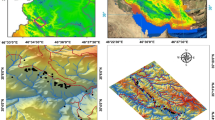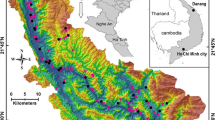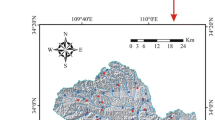Abstract
The main aim of this study was to evaluate and compare the results of two data-mining algorithms including support vector machine (SVM) and logistic model tree (LMT) for shallow landslide modelling in Kamyaran county where located in Kurdistan Province, Iran. A total of 60 landslide locations were identified using different sources and randomly divided into a ratio of 70/30 for landslide modeling and validation process. After that, 21 conditioning factors, with a raster resolution of 20 m, based on the information gain ratio (IGR) technique were selected. Performance of the models was evaluated using area under the receiver-operating characteristic curve (AUROC), and also several statistical-based indexes. Results depicted that only eight factors including distance to river, river density, stream power index (SPI), rainfall, valley depth, topographic wetness index (TWI), solar radiation, and plan curvature were known more effective for landslide modeling using training data set. The results also revealed that the SVM model (AUROC = 0.882) outperformed and outclassed the LMT model (AUROC = 0.737). Therefore, analysis and comparison of the results showed that the SVM model by RBF function performed well for landslide spatial prediction in the study area. Eventually, the findings of this study can be useful for land-use planning, reducing the risk of landslide, and decision-making in areas prone to landslide.







Similar content being viewed by others
References
Abedini M, Ghasemyan B, Mogaddam MR (2017) Landslide susceptibility mapping in Bijar city, Kurdistan Province, Iran: a comparative study by logistic regression and AHP models. Environ Earth Sci 76:308. https://doi.org/10.1007/s12665-017-6502-3
Abedini M, Ghasemian B, Shirzadi A, Shahabi H, Chapi K, Pham BT, Bin Ahmad B, Tien Bui D (2018) A novel hybrid approach of bayesian logistic regression and its ensembles for landslide susceptibility assessment. Geocarto Int. https://doi.org/10.1080/10106049.2018.1499820
Ahmad A, Dey L (2005) A feature selection technique for classificatory analysis. Pattern Recogn Lett 26:43–56
Ahmadlou M, Karimi M, Alizadeh S, Shirzadi A, Parvinnejhad D, Shahabi H, Panahi M (2018) Flood susceptibility assessment using integration of adaptive network-based fuzzy inference system (ANFIS) and biogeography-based optimization (BBO) and BAT algorithms (BA). Geocarto Int. https://doi.org/10.1080/10106049.2018.1474276
Ballabio C, Sterlacchini S (2012) Support vector machines for landslide susceptibility mapping: the Staffora River Basin case study, Italy. Math Geosci 44:47–70
Bennett ND, Croke BF, Guariso G, Guillaume JH, Hamilton SH, Jakeman AJ, Marsili-Libelli S, Newham LT, Norton JP, Perrin C (2013) Characterising performance of environmental models. Environ Model Softw 40:1–20
Bui DT, Tuan TA, Klempe H, Pradhan B, Revhaug I (2016) Spatial prediction models for shallow landslide hazards: a comparative assessment of the efficacy of support vector machines, artificial neural networks, kernel logistic regression, and logistic model tree. Landslides 13:361–378
Bui DT, Panahi M, Shahabi H, Singh VP, Shirzadi A, Chapi K, Khosravi K, Chen W, Panahi S, Li S (2018) Novel hybrid evolutionary algorithms for spatial prediction of floods. Sci Rep 8:15364
Chapi K, Singh VP, Shirzadi A, Shahabi H, Bui DT, Pham BT, Khosravi K (2017) A novel hybrid artificial intelligence approach for flood susceptibility assessment. Environ Model Softw 95:229–245
Chen W, Shirzadi A, Shahabi H, Ahmad BB, Zhang S, Hong H, Zhang N (2017) A novel hybrid artificial intelligence approach based on the rotation forest ensemble and naïve Bayes tree classifiers for a landslide susceptibility assessment in Langao County, China. Geomatics, Natural Hazards and Risk 8:1955–1977
Chen W, Shahabi H, Shirzadi A, Hong H, Akgun A, Tian Y, Liu J, Zhu A-X, Li S (2018a) Novel hybrid artificial intelligence approach of bivariate statistical-methods-based kernel logistic regression classifier for landslide susceptibility modeling. Bull Eng Geol Environ. https://doi.org/10.1007/s10064-018-1401-8
Chen W, Shahabi H, Shirzadi A, Li T, Guo C, Hong H, Li W, Pan D, Hui J, Ma M (2018b) A novel ensemble approach of bivariate statistical-based logistic model tree classifier for landslide susceptibility assessment. Geocarto Int. https://doi.org/10.1080/10106049.2018.1425738
Chen W, Shahabi H, Zhang S, Khosravi K, Shirzadi A, Chapi K, Pham B, Zhang T, Zhang L, Chai H (2018c) Landslide susceptibility modeling based on gis and novel bagging-based kernel logistic regression. Applied Sciences 8:2540
Chen W, Zhao X, Shahabi H, Shirzadi A, Khosravi K, Chai H, Zhang S, Zhang L, Ma J, Chen Y (2019) Spatial prediction of landslide susceptibility by combining evidential belief function, logistic regression and logistic model tree. Geocarto International:1-25
Cho JH, Kurup PU (2011) Decision tree approach for classification and dimensionality reduction of electronic nose data. Sensors Actuators B 160:542–548
Costanzo D, Rotigliano E, Irigaray Fernández C, Jiménez-Perálvarez JD, Chacón Montero J (2012) Factors selection in landslide susceptibility modelling on large scale following the gis matrix method: application to the river Beiro basin (Spain). Nat Hazards Earth Syst Sci 12(2):327–340. https://doi.org/10.5194/nhess-12-327-2012
Cristianini N, Shawe-Taylor J (2000) An introduction to support vector machines and other kernel-based learning methods. Cambridge University Press, Cambridge
Cruden DM (1991) A simple definition of a landslide. Bull Eng Geol Env 43:27–29
Dahal RK, Hasegawa S, Nonomura A, Yamanaka M, Masuda T, Nishino K (2008) GIS-based weights-of-evidence modelling of rainfall-induced landslides in small catchments for landslide susceptibility mapping. Environ Geol 54:311–324
Dai F, Lee C, Ngai YY (2002) Landslide risk assessment and management: an overview. Eng Geol 64:65–87
Das I, Stein A, Kerle N, Dadhwal VK (2012) Landslide susceptibility mapping along road corridors in the Indian Himalayas using Bayesian logistic regression models. Geomorphology 179:116–125
Debeljak M, Dzeroski S (2009) Applications of data mining in ecological modelling. Handbook of ecological modelling and informatics. WIT Press, Southampton, pp 409–423
Doetsch P, Buck C, Golik P, Hoppe N, Kramp M, Laudenberg J, Oberdörfer C, Steingrube P, Forster J, Mauser A (2009) Logistic model trees with auc split criterion for the kdd cup 2009 small challenge.In: Proceedings of the 2009 International Conference on KDD-Cup 2009-volume 7. JMLR org pp 77-88
Guzzetti F, Carrara A, Cardinali M, Reichenbach P (1999) Landslide hazard evaluation: a review of current techniques and their application in a multi-scale study, Central Italy. Geomorphology 31:181–216
Han J, Pei J, Kamber M (2011) Data mining: concepts and techniques. Elsevier, Amsterdam
Hastie T, Tibshirani R, Friedman J (2002) The elements of statistical learning: data mining, inference, and prediction. biometrics. Springer, Berlin
He Q, Shahabi H, Shirzadi A, Li S, Chen W, Wang N, Chai H, Bian H, Ma J, Chen Y (2019) Landslide spatial modelling using novel bivariate statistical based Naïve Bayes, RBF Classifier, and RBF network machine learning algorithms. Sci Total Environ 663:1–15
Hong H, Pradhan B, Xu C, Bui DT (2015) Spatial prediction of landslide hazard at the Yihuang area (China) using two-class kernel logistic regression, alternating decision tree and support vector machines. CATENA 133:266–281
Hong H, Pourghasemi HR, Pourtaghi ZS (2016) Landslide susceptibility assessment in Lianhua county (China): a comparison between a random forest data mining technique and bivariate and multivariate statistical models. Geomorphology 259:105–118
Hong H, Chen W, Xu C, Youssef AM, Pradhan B, Tien Bui D (2017a) Rainfall-induced landslide susceptibility assessment at the Chongren area (China) using frequency ratio, certainty factor, and index of entropy. Geocarto Int 32:139–154
Hong H, Ilia I, Tsangaratos P, Chen W, Xu C (2017b) A hybrid fuzzy weight of evidence method in landslide susceptibility analysis on the Wuyuan area, China. Geomorphology 290:1–16
Hong H, Liu J, Zhu A-X, Shahabi H, Pham BT, Chen W, Pradhan B, Bui DT (2017c) A novel hybrid integration model using support vector machines and random subspace for weather-triggered landslide susceptibility assessment in the Wuning area (China). Environ Earth Sci 76:652
Hong H, Liu J, Bui DT, Pradhan B, Acharya TD, Pham BT, Zhu A-X, Chen W, Ahmad BB (2018a) Landslide susceptibility mapping using J48 Decision tree with AdaBoost, bagging and rotation forest ensembles in the Guangchang area (China). CATENA 163:399–413
Hong H, Panahi M, Shirzadi A, Ma T, Liu J, Zhu A-X, Chen W, Kougias I, Kazakis N (2018b) Flood susceptibility assessment in Hengfeng area coupling adaptive neuro-fuzzy inference system with genetic algorithm and differential evolution. Sci Total Environ 621:1124–1141
Huang Y, Zhao L (2018) Review on landslide susceptibility mapping using support vector machines. CATENA 165:520–529
Jiménez-Perálvarez J, Irigaray C, El Hamdouni R, Chacón J (2011) Landslide-susceptibility mapping in a semi-arid mountain environment: an example from the southern slopes of Sierra Nevada (Granada, Spain). Bull Eng Geol Env 70:265–277
Kavzoglu T, Sahin EK, Colkesen I (2015) An assessment of multivariate and bivariate approaches in landslide susceptibility mapping: a case study of Duzkoy district. Nat Hazards 76:471–496
Khosravi K, Pham BT, Chapi K, Shirzadi A, Shahabi H, Revhaug I, Prakash I, Bui DT (2018) A comparative assessment of decision trees algorithms for flash flood susceptibility modeling at Haraz watershed, northern Iran. Sci Total Environ 627:744–755
Landwehr N, Hall M, Frank E (2005) Logistic model trees. Mach Learn 59:161–205
Miraki S, Zanganeh SH, Chapi K, Singh VP, Shirzadi A, Shahabi H, Pham BT (2018) Mapping groundwater potential using a novel hybrid intelligence approach. Water Res Manag. https://doi.org/10.1007/s11269-018-2102-6
Mousavi SZ, Kavian A, Soleimani K, Mousavi SR, Shirzadi A (2011) GIS-based spatial prediction of landslide susceptibility using logistic regression model. Geomat Nat Hazards Risk 2:33–50
Murthy SK (1998) Automatic construction of decision trees from data: a multi-disciplinary survey. Data Min Knowl Discov 2:345–389
Myles AJ, Feudale RN, Liu Y, Woody NA, Brown SD (2004) An introduction to decision tree modeling. J Chemom 18:275–285
Nguyen VV, Pham BT, Vu BT, Prakash I, Jha S, Shahabi H, Shirzadi A, Ba DN, Kumar R, Chatterjee JM (2019) Hybrid machine learning approaches for landslide susceptibility modeling. Forests 10:157
Nithya N, Duraiswamy K (2014) Gain ratio based fuzzy weighted association rule mining classifier for medical diagnostic interface. Sadhana 39:39–52
Peng L, Niu R, Huang B, Wu X, Zhao Y, Ye R (2014) Landslide susceptibility mapping based on rough set theory and support vector machines: a case of the three Gorges area, China. Geomorphology 204:287–301
Pham BT, Tien Bui D, Indra P, Dholakia M (2015a) A comparison study of predictive ability of support vector machines and naive bayes tree methods in landslide susceptibility assessment at an area between Tehri Garhwal and Pauri Garhwal, Uttarakhand state (India) using GIS In: National Symposium on Geomatics for Digital India and annual conventions of ISG and ISRS, Jaipur (India).
Pham BT, Tien Bui D, Indra P, Dholakia M (2015b) Landslide susceptibility assessment at a part of Uttarakhand Himalaya, India using GIS–based statistical approach of frequency ratio method. Int J Eng Res Technol 4:338–344
Pham BT, Pradhan B, Bui DT, Prakash I, Dholakia M (2016) A comparative study of different machine learning methods for landslide susceptibility assessment: a case study of Uttarakhand area (India). Environ Model Softw 84:240–250
Pham BT, Bui DT, Pourghasemi HR, Indra P, Dholakia M (2017) Landslide susceptibility assessment in the Uttarakhand area (India) using GIS: a comparison study of prediction capability of naïve bayes, multilayer perceptron neural networks, and functional trees methods. Theor Appl Climatol 128:255–273
Pham BT, Shirzadi A, Bui DT, Prakash I, Dholakia M (2018a) A hybrid machine learning ensemble approach based on a radial basis function neural network and Rotation Forest for landslide susceptibility modeling: a case study in the Himalayan area, India. Int J Sedim Res 33:157–170
Pham BT, Prakash I, Dou J, Singh SK, Trinh PT, Trung Tran H, Le Minh T, Tran VP, Kim Khoi D, Shirzadi A (2018b) A novel hybrid approach of landslide susceptibility modeling using rotation forest ensemble and different base classifiers. Geocarto Int. https://doi.org/10.1080/10106049.2018.1559885
Pham BT, Prakash I, Singh SK, Shirzadi A, Shahabi H, Bui DT (2019) Landslide susceptibility modeling using reduced error pruning trees and different ensemble techniques: hybrid machine learning approaches. CATENA 175:203–218
Pourghasemi HR, Jirandeh AG, Pradhan B, Xu C, Gokceoglu C (2013) Landslide susceptibility mapping using support vector machine and GIS at the Golestan Province, Iran. J Earth Syst Sci 122:349–369
Pradhan B (2011) Use of GIS-based fuzzy logic relations and its cross application to produce landslide susceptibility maps in three test areas in Malaysia. Environ Earth Sci 63:329–349
Pradhan B (2013) A comparative study on the predictive ability of the decision tree, support vector machine and neuro-fuzzy models in landslide susceptibility mapping using GIS. Comput Geosci 51:350–365
Quinlan JR (1993) C4. 5: Programming for machine learning. Morgan Kauffmann, Burlington
Quinlan JR (1996) Bagging, boosting, and C4. 5. AAAI/IAAI 1:725–730
Regmi AD, Devkota KC, Yoshida K, Pradhan B, Pourghasemi HR, Kumamoto T, Akgun A (2014) Application of frequency ratio, statistical index, and weights-of-evidence models and their comparison in landslide susceptibility mapping in Central Nepal Himalaya. Arab J Geosci 7:725–742
Schölkopf B, Smola AJ, Williamson RC, Bartlett PL (2000) New support vector algorithms. Neural Comput 12:1207–1245
Shafizadeh-Moghadam H, Valavi R, Shahabi H, Chapi K, Shirzadi A (2018) Novel forecasting approaches using combination of machine learning and statistical models for flood susceptibility mapping. J Environ Manag 217:1–11
Shirzadi A, Saro L, Joo OH, Chapi K (2012) A GIS-based logistic regression model in rock-fall susceptibility mapping along a mountainous road: Salavat Abad case study, Kurdistan, Iran. Nat Hazards 64:1639–1656
Shirzadi A, Bui DT, Pham BT, Solaimani K, Chapi K, Kavian A, Shahabi H, Revhaug I (2017a) Shallow landslide susceptibility assessment using a novel hybrid intelligence approach. Environ Earth Sci 76:60
Shirzadi A, Chapi K, Shahabi H, Solaimani K, Kavian A, Ahmad BB (2017b) Rock fall susceptibility assessment along a mountainous road: an evaluation of bivariate statistic, analytical hierarchy process and frequency ratio. Environ Earth Sci 76:152
Shirzadi A, Shahabi H, Chapi K, Bui DT, Pham BT, Shahedi K, Ahmad BB (2017c) A comparative study between popular statistical and machine learning methods for simulating volume of landslides. CATENA 157:213–226
Shirzadi A, Soliamani K, Habibnejhad M, Kavian A, Chapi K, Shahabi H, Chen W, Khosravi K, Pham B, Pradhan BT (2018) Novel GIS based machine learning algorithms for shallow landslide susceptibility mapping. Sensors 18:3777
Shirzadi A, Solaimani K, Roshan MH, Kavian A, Chapi K, Shahabi H, Keesstra S, Ahmad BB, Bui DT (2019) Uncertainties of prediction accuracy in shallow landslide modeling: sample size and raster resolution. CATENA 178:172–188
Tien Bui D, Pradhan B, Lofman O, Revhaug I (2012) Landslide susceptibility assessment in Vietnam using support vector machines, decision tree, and Naive Bayes models. Math Probl Eng. https://doi.org/10.1155/2012/974638
Tien Bui D, Khosravi K, Li S, Shahabi H, Panahi M, Singh V, Chapi K, Shirzadi A, Panahi S, Chen W (2018a) New hybrids of anfis with several optimization algorithms for flood susceptibility modeling. Water 10:1210
Tien Bui D, Shahabi H, Shirzadi A, Chapi K, Alizadeh M, Chen W, Mohammadi A, Ahmad B, Panahi M, Hong H (2018b) Landslide detection and susceptibility mapping by AIRSAR data using support vector machine and index of entropy models in Cameron Highlands, Malaysia. Remote Sens 10:1527
Tien Bui D, Shahabi H, Shirzadi A, Chapi K, Hoang N-D, Pham B, Bui Q-T, Tran C-T, Panahi M, Bin Ahamd B (2018c) A novel integrated approach of relevance vector machine optimized by imperialist competitive algorithm for spatial modeling of shallow landslides. Remote Sens 10:1538
Tien Bui D, Shahabi H, Shirzadi A, Chapi K, Pradhan B, Chen W, Khosravi K, Panahi M, Bin Ahmad B, Saro L (2018d) Land subsidence susceptibility mapping in South Korea using machine learning algorithms. Sensors 18:2464
Tsangaratos P, Ilia I (2016) Landslide susceptibility mapping using a modified decision tree classifier in the Xanthi Perfection, Greece. Landslides 13:305–320
Vapnik V (1998) Statistical learning theory. Wiley, New York
Xu C, Xu X, Lee YH, Tan X, Yu G, Dai F (2012) The 2010 Yushu earthquake triggered landslide hazard mapping using GIS and weight of evidence modeling. Environ Earth Sci 66:1603–1616
Yao X, Tham L, Dai F (2008) Landslide susceptibility mapping based on support vector machine: a case study on natural slopes of Hong Kong, China. Geomorphology 101:572–582
Yesilnacar E, Topal T (2005) Landslide susceptibility mapping: a comparison of logistic regression and neural networks methods in a medium scale study, Hendek region (Turkey). Eng Geol 79:251–266
Zhang G, Cai Y, Zheng Z, Zhen J, Liu Y, Huang K (2016) Integration of the statistical index method and the analytic hierarchy process technique for the assessment of landslide susceptibility in Huizhou, China. Catena 142:233–244
Zhao Y, Zhang Y (2008) Comparison of decision tree methods for finding active objects. Adv Space Res 41:1955–1959
Acknowledgements
The authors gratefully acknowledge of the Forests, Rangelands and Watershed Management Organization of Iran for preparing the report of landslide location in the study area, and are thankful to the members of geomorphology department of Mohaghegh Ardabil University and director of environmental management organization of Kurdistan. Ultimately, the authors would like to thank two anonymous honor reviewers and the editor for their helpful comments on the previous version of this manuscript.
Author information
Authors and Affiliations
Corresponding author
Additional information
Publisher's Note
Springer Nature remains neutral with regard to jurisdictional claims in published maps and institutional affiliations.
Rights and permissions
About this article
Cite this article
Abedini, M., Ghasemian, B., Shirzadi, A. et al. A comparative study of support vector machine and logistic model tree classifiers for shallow landslide susceptibility modeling. Environ Earth Sci 78, 560 (2019). https://doi.org/10.1007/s12665-019-8562-z
Received:
Accepted:
Published:
DOI: https://doi.org/10.1007/s12665-019-8562-z




